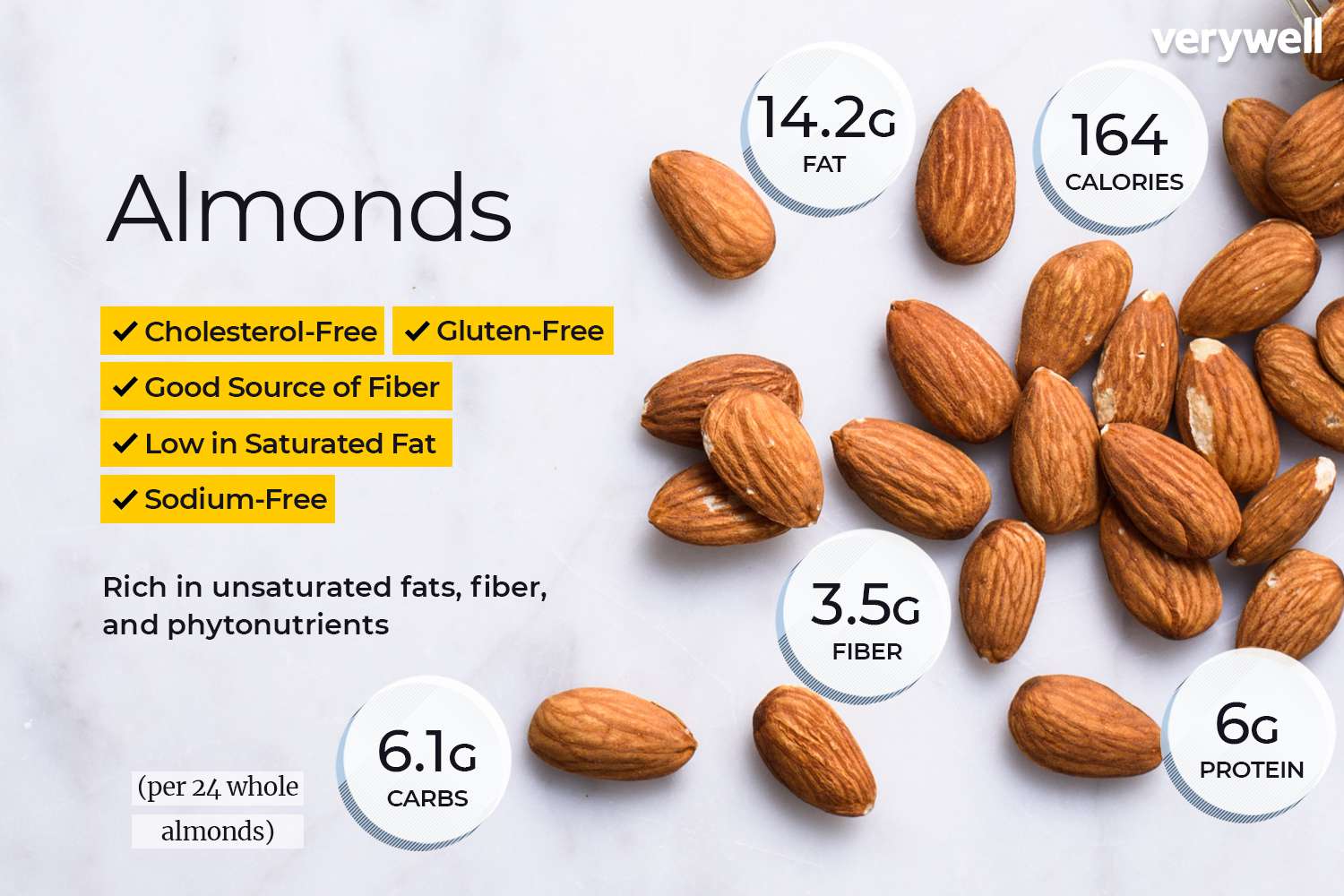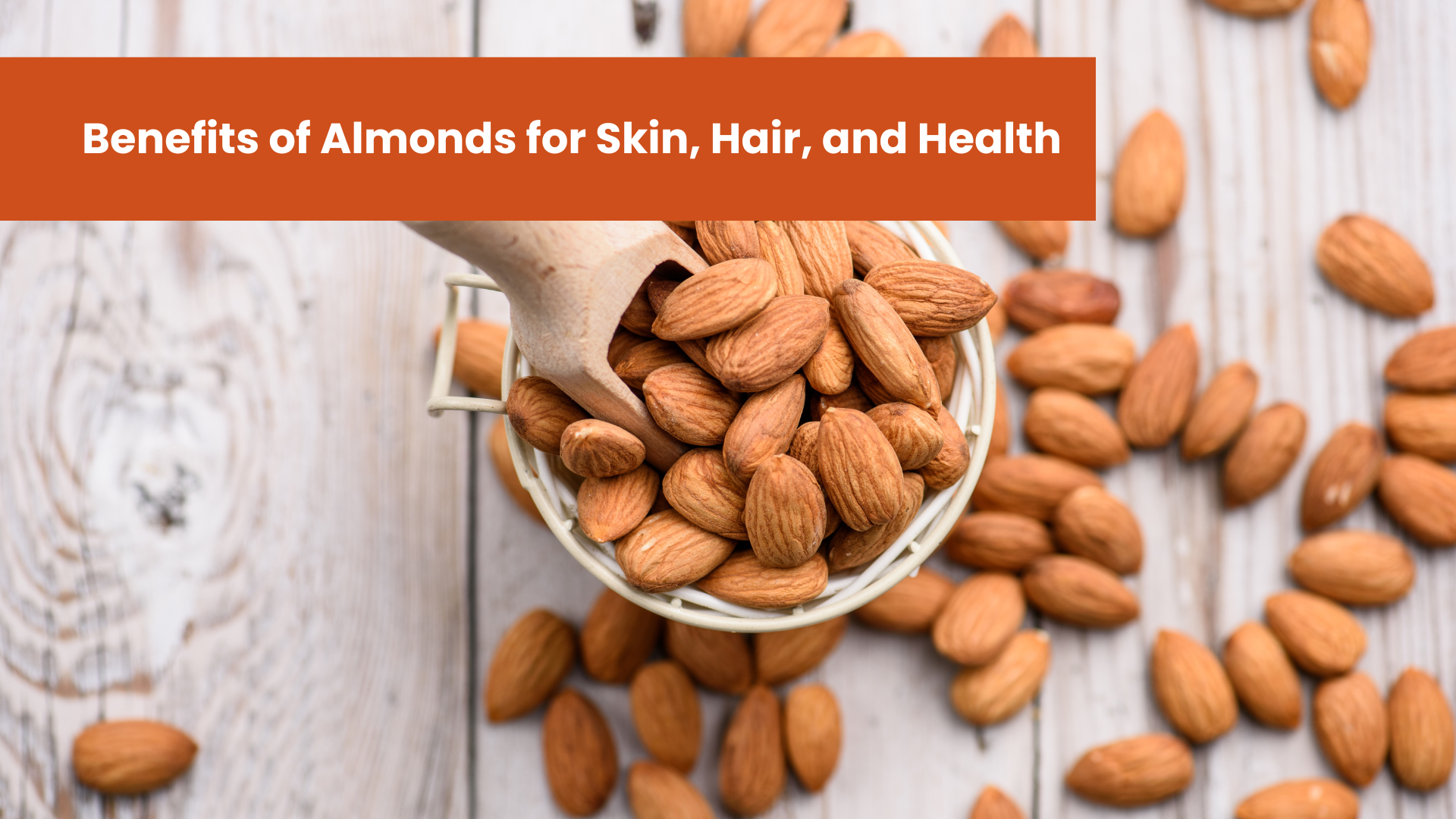Introduction to Almonds

source: britannica.com
General Background
Almonds stand as one of nature’s most nutritious gifts, packed with essential nutrients that support overall health. These oval-shaped nuts, technically seeds of the Prunus dulcis tree, have earned their reputation as a nutritional powerhouse across centuries of human consumption.
Almonds are a tree nut native to the Mediterranean region, where they’ve been cherished for their remarkable nutritional profile and versatility. [#1] Their slightly sweet flavor and satisfying crunch have made them a favorite ingredient in cuisines worldwide, from savory dishes to decadent desserts.
What many people don’t realize is that the almond isn’t actually a true nut botanically speaking—it’s the seed of a drupe fruit related to peaches, cherries, and plums. This botanical distinction doesn’t diminish their nutritional value, however, as almonds remain one of the most nutrient-dense foods available.
Source and Cultivation
The history of almond cultivation runs deep through human civilization. Archaeological evidence suggests almond trees were cultivated as early as 3000 BC, making them one of humanity’s oldest cultivated tree nuts. This long-standing relationship between humans and almonds speaks volumes about their value as a food source.
Historical records show almonds have been mentioned in Hebrew literature from 2,000 B.C., highlighting their significance in ancient cultures. [#2] Their portability, long shelf life, and concentrated nutrition made them particularly valuable in ancient times when food preservation presented significant challenges.
Almonds were popular in the diets of ancient Egyptians and Indian populations, who recognized their health-promoting properties long before modern nutritional science confirmed their benefits. These civilizations incorporated almonds into their culinary traditions and medicinal practices, laying the groundwork for their continued popularity today.
Today, California produces about 80% of the world’s almond supply, though the nut’s origins trace back to the Mediterranean and Middle East. The transition from wild harvesting to organized cultivation has allowed for greater production while maintaining the nutritional integrity that makes almonds so beneficial.
Almonds are considered an important part of the Mediterranean diet, which is frequently associated with heart health and longevity. This eating pattern, rich in plant foods, healthy fats, and minimal processed ingredients, showcases almonds as a staple component—a testament to their nutritional significance.
The cultivation process for almonds requires specific growing conditions, including mild, wet winters and hot, dry summers. Almond trees bloom in early spring, producing beautiful pink and white flowers before developing the fruits that contain the almonds we consume. This seasonal cycle has remained largely unchanged for thousands of years, connecting modern consumers to ancient agricultural traditions.
Nutritional Profile of Almonds

Source: verywellfit.com
Key Nutrients
Almonds pack an impressive nutritional punch in their small, crunchy package. These nutrient-dense seeds contain a remarkable array of vitamins, minerals, and beneficial compounds that contribute to their status as a superfood. Almonds are a rich source of vitamin E, monounsaturated fats, fiber, biotin, calcium, phosphorus, magnesium, copper, and various phytonutrients.
The nutritional composition of almonds makes them stand out among other snack options. Their balanced profile of macronutrients and micronutrients supports multiple bodily functions, from cellular protection to bone health. Let’s explore the specific nutrients that make almonds such a valuable addition to any diet.
Antioxidant Vitamin E
Almonds shine as an exceptional source of vitamin E, a powerful antioxidant that helps protect cells from oxidative damage. Just one ounce (about 23 almonds) provides a whopping 50% of the Daily Value for vitamin E. [#3] This makes almonds one of the most concentrated food sources of this essential vitamin.
Vitamin E plays several crucial roles in the body:
- Protects cell membranes from free radical damage
- Supports immune function
- Helps maintain healthy skin
- May slow cognitive decline associated with aging
The alpha-tocopherol form of vitamin E found in almonds is particularly bioavailable, meaning your body can efficiently absorb and utilize it. This antioxidant protection is especially valuable in our modern environment, where we face numerous oxidative stressors daily.
Fiber Content
Almonds provide substantial dietary fiber, with about 3 grams per ounce. This fiber content contributes to their satisfying nature and supports digestive health. The fiber in almonds is a mix of soluble and insoluble types, each offering distinct benefits.
Soluble fiber helps regulate blood sugar and cholesterol levels, while insoluble fiber adds bulk to stool and promotes regular bowel movements. Together, these fiber types support a healthy gut microbiome, which research increasingly links to overall health and immunity.
Magnesium and Other Minerals
Almonds stand out as an excellent source of magnesium, a mineral involved in over 300 biochemical reactions in the body. Magnesium plays a vital role in muscle and nerve function, blood glucose control, and bone health.
Beyond magnesium, almonds contain a spectrum of other essential minerals:
- Calcium: Supports bone health and muscle function
- Phosphorus: Works with calcium for bone formation
- Copper: Assists with iron metabolism and connective tissue formation
- Manganese: Involved in metabolism and antioxidant systems
- Zinc: Supports immune function and wound healing
This mineral profile makes almonds particularly valuable for those following plant-based diets, as they provide several minerals that can sometimes be challenging to obtain from plant sources alone.
Plant Protein
With 6 grams of protein per ounce, almonds offer a substantial amount of plant-based protein. While not a complete protein source on their own, almonds contain all essential amino acids in varying amounts, contributing to your daily protein needs.
The protein in almonds helps with muscle maintenance, immune function, and satiety. When combined with other protein sources throughout the day, almonds can be part of a balanced approach to meeting protein requirements, especially for those limiting animal products.
Healthy Fats
Almonds contain primarily monounsaturated fats, the same heart-healthy type found in olive oil. These fats help reduce LDL (bad) cholesterol while maintaining HDL (good) cholesterol levels. The fat content in almonds also aids in the absorption of fat-soluble vitamins like vitamin E.
Despite their relatively high fat content, research shows that regular almond consumption doesn’t contribute to weight gain when consumed as part of a balanced diet. In fact, the combination of fat, protein, and fiber in almonds promotes fullness, potentially reducing overall calorie intake.
Caloric and Macronutrient Breakdown
A standard one-ounce serving of almonds (approximately 23 nuts) provides:
- 165 calories
- 6 grams of protein
- 14 grams of fat (primarily monounsaturated)
- 6 grams of carbohydrates
- 3 grams of fiber
This macronutrient distribution makes almonds a balanced snack option that provides sustained energy without causing blood sugar spikes. The moderate carbohydrate content, much of which is fiber, makes almonds suitable for various dietary approaches, including lower-carbohydrate eating patterns.
Almonds also contain riboflavin (vitamin B2), which plays a key role in energy production and cellular function. This B vitamin helps convert food into energy and maintains proper functioning of the nervous system.
The nutritional density of almonds makes them an excellent choice for those looking to maximize nutrient intake while managing calories. Their combination of protein, healthy fats, and fiber creates a nutritional trifecta that supports overall health and wellbeing.
Health Benefits of Almonds

Source: krishival.com/blogs
Heart Health
Almonds have earned their reputation as a heart-healthy food through numerous scientific studies. Research consistently shows that regular consumption of these nutritious nuts can significantly improve cardiovascular health markers. Almonds have been suggested to reduce heart disease risk by lowering total and LDL cholesterol.
The heart benefits of almonds stem from their unique nutritional composition:
- Monounsaturated fats that help maintain healthy cholesterol levels
- Vitamin E that protects against oxidative damage to blood vessels
- Magnesium that supports proper heart rhythm and blood pressure
- Plant sterols that block cholesterol absorption
- L-arginine, an amino acid that improves blood vessel function
Perhaps most compelling is the evidence from long-term observational research. Studies have found a lower risk of heart disease in those eating nuts at least four times a week. This protective effect remains consistent across different populations and dietary patterns.
Brain Function
The nutrients in almonds support cognitive health in multiple ways. Their high vitamin E content helps protect brain cells from oxidative damage, which may slow age-related mental decline. Additionally, the riboflavin (vitamin B2) in almonds plays a crucial role in brain energy production.
The healthy fats in almonds are particularly valuable for brain health. Our brains consist of approximately 60% fat, and the monounsaturated fats found in almonds provide building blocks for brain cell membranes and neurotransmitters. Regular consumption may support memory, focus, and overall cognitive performance.
Blood Sugar Control
For those concerned about blood sugar management, almonds offer substantial benefits. Almonds have been shown to have positive effects on glucose tolerance. Their combination of protein, healthy fats, and fiber helps slow the absorption of sugar into the bloodstream, preventing rapid spikes and crashes in glucose levels.
The magnesium content in almonds further supports blood sugar regulation by improving insulin sensitivity. Almonds may help regulate blood sugar levels and prevent diabetes. Adding a small handful of almonds to carbohydrate-rich meals can moderate the glycemic impact, making them an excellent choice for those with prediabetes or diabetes.
Weight Management
Despite their calorie density, almonds can be a valuable ally in weight management efforts. Studies suggest almonds can help with weight loss despite their higher calorie content. This seemingly contradictory effect occurs through several mechanisms:
- The fiber, protein, and fat in almonds promote satiety, reducing overall hunger
- The chewing required for whole almonds increases satisfaction
- Not all calories in almonds are fully absorbed by the body
- Their nutrient profile supports metabolic health
Research indicates that incorporating almonds as a snack can lead to greater weight loss compared to carbohydrate-based snacks with equivalent calories. Their ability to satisfy hunger while providing steady energy makes them particularly effective for maintaining weight loss long-term.
Skin Health
The nutritional profile of almonds offers significant benefits for skin health and appearance. Vitamin E, abundant in almonds, helps protect skin cells from UV damage and other environmental stressors. This antioxidant protection may reduce signs of aging and support skin repair processes.
The healthy fats in almonds contribute to skin moisture and elasticity from within. These fats help strengthen cell membranes, allowing skin cells to retain water more effectively. Regular consumption may result in more supple, hydrated skin with improved barrier function against irritants and pollutants.
Digestive Health
Almonds contribute to digestive wellness through their fiber content and prebiotic effects. The fiber in almonds adds bulk to stool and promotes regular bowel movements, helping prevent constipation. Additionally, this fiber serves as food for beneficial gut bacteria, supporting a healthy microbiome.
Interestingly, the skins of almonds contain prebiotic compounds that specifically nourish beneficial bacteria species in the gut. These microorganisms produce short-chain fatty acids that nourish colon cells and reduce inflammation throughout the digestive tract. For maximum digestive benefits, choose almonds with skins intact rather than blanched varieties.
Cancer and Inflammation Prevention
The antioxidant compounds in almonds may offer protection against certain types of cancer. Vitamin E, flavonoids, and other phytonutrients in almonds neutralize free radicals that can damage DNA and potentially initiate cancer development. While no single food can prevent cancer, almonds form part of a protective dietary pattern.
Chronic inflammation underlies many modern diseases, and almonds contain several anti-inflammatory compounds. Their combination of monounsaturated fats, antioxidants, and magnesium helps modulate inflammatory responses in the body. Including almonds regularly in your diet may contribute to lower systemic inflammation levels.
Dental and Bone Health
Almonds provide several nutrients essential for maintaining strong teeth and bones. Their calcium, phosphorus, and magnesium work together to support bone mineral density. While the calcium in almonds isn’t as readily absorbed as dairy calcium, it still contributes to overall intake.
For dental health, almonds offer multiple benefits. Their crunchy texture stimulates saliva production, which helps neutralize acids and remineralize tooth enamel. Additionally, almonds are low in fermentable carbohydrates that feed cavity-causing bacteria. The phosphorus in almonds also plays a role in rebuilding tooth enamel.
Role in the Mediterranean Diet
Almonds feature prominently in the Mediterranean diet, one of the most thoroughly researched and health-promoting dietary patterns worldwide. This eating style, characterized by abundant plant foods, healthy fats, and moderate protein, consistently shows benefits for heart health, longevity, and chronic disease prevention.
As part of this dietary approach, almonds provide plant protein, healthy fats, and micronutrients that complement other Mediterranean staples like olive oil, vegetables, and fish. Their versatility allows them to be incorporated into meals throughout the day, from breakfast to dessert. The synergistic effects of almonds with other Mediterranean foods may explain some of their impressive health benefits in population studies.
Almonds in Traditional Medicine

Source: nature.com
Historical Uses
Long before modern nutritional science confirmed the health benefits of almonds, these nuts held a revered place in traditional medicine systems across various civilizations. Almonds were popular in the diets of ancient Egyptians and Indian populations. Egyptian physicians prescribed almond preparations for numerous ailments, recognizing their therapeutic potential centuries before laboratory analysis could identify their beneficial compounds.
In Ayurvedic medicine, one of the world’s oldest holistic healing systems, almonds were classified as a sattvic food—believed to promote clarity, intelligence, and balance. Practitioners recommended almonds for:
- Strengthening the nervous system
- Improving intellectual capacity
- Enhancing male fertility
- Reducing inflammation in the body
- Supporting respiratory health
Traditional Chinese Medicine (TCM) incorporated almonds in two distinct forms. Sweet almonds were used to moisten the lungs and relieve coughs, while bitter almonds (used in tiny, controlled amounts due to their toxicity) were applied externally for skin conditions. TCM practitioners often paired almonds with other herbs to create balanced formulations for treating specific health imbalances.
Cultural Significance
Beyond their medicinal applications, almonds carried profound cultural symbolism across many societies. In Mediterranean cultures, almonds represented divine blessing and fertility. The almond’s early spring blossoming made it a symbol of rebirth and new beginnings. This symbolism extended to wedding traditions, where almonds often featured as gifts representing wishes for children, happiness, wealth, health, and longevity.
In Middle Eastern healing traditions, almond oil served as a base for numerous remedies. Healers valued it for:
- Soothing irritated skin conditions
- Treating ear infections when warmed
- Relieving muscle aches when used in massage
- Conditioning hair and scalp
- Improving digestive function when consumed
Interestingly, many traditional uses align remarkably well with contemporary research findings. For instance, the ancient practice of consuming soaked almonds for improved digestion and nutrient absorption parallels modern understanding of how soaking reduces phytic acid and enhances bioavailability of minerals. Similarly, the traditional application of almond oil for skin conditions corresponds with current knowledge about vitamin E’s role in skin health.
Folk medicine across Europe incorporated almonds into remedies for coughs, constipation, and even as a purported cancer preventative. Sweet almond oil became a staple in folk pharmacopeia, used both internally and externally. The persistence of these practices across diverse cultures suggests observable benefits that predated scientific validation.
Today, as interest in plant-based alternatives to dairy grows, almond milk has gained popularity worldwide. However, this application isn’t entirely modern—medieval cookbooks and medical texts from various cultures document almond milk preparations as substitutes during religious fasting periods and as digestive aids. This historical precedent for almond milk as both food and medicine shows how traditional wisdom sometimes anticipates modern dietary trends, connecting ancient practices with contemporary nutrition approaches like those that incorporate coconut milk and other plant-based alternatives.
Comparative Analysis: Almonds vs. Other Nuts

Source: healthline.com
Nutrient Comparison
When examining the nutritional landscape of tree nuts, almonds stand out in several categories. While all nuts offer health benefits, their nutritional profiles vary significantly, making certain varieties more suitable for specific health goals.
Almonds distinguish themselves from other popular nuts in several key areas. Compared to walnuts, for instance, almonds provide substantially more fiber, calcium, and vitamin E. This makes them particularly valuable for individuals focused on bone health, digestive wellness, or antioxidant protection.
Let’s break down how almonds stack up against other common nuts:
- Protein content: Almonds contain more protein than many competing nuts, with approximately 6 grams per ounce. This higher protein concentration makes them an excellent choice for plant-based diets or anyone looking to increase their protein intake without consuming animal products.
- Fat profile: While all nuts contain healthy fats, the composition differs. Almonds feature more monounsaturated fat and less polyunsaturated fat than walnuts. This fat profile resembles olive oil, which has long been associated with heart health benefits in Mediterranean diets.
- Calcium: Among nuts, almonds rank as one of the best non-dairy sources of calcium, containing nearly 75mg per ounce – significantly more than cashews, walnuts, or pistachios.
- Fiber: With about 3.5 grams of fiber per ounce, almonds outperform many other nuts in this category, supporting digestive health and promoting satiety.
The mineral content of almonds also deserves attention. While pumpkin seeds might win for zinc and iron content, almonds provide an impressive array of minerals including magnesium, phosphorus, and potassium. This mineral diversity supports everything from muscle function to bone health.
Health Benefits Comparison
Different nuts offer varying health advantages based on their unique nutritional compositions. Almonds excel in several health-promoting categories:
- Cardiovascular support: While walnuts receive praise for their omega-3 content, almonds shine for their combination of monounsaturated fats, fiber, and antioxidants that collectively support heart health through multiple mechanisms.
- Blood sugar regulation: Compared to cashews and pistachios, almonds have a lower glycemic impact and higher fiber content, making them particularly beneficial for blood glucose management.
- Weight management: The protein-fat-fiber combination in almonds creates greater satiety than many other nuts, potentially helping with appetite control.
- Skin health: The vitamin E concentration in almonds surpasses that of other nuts, providing superior protection against oxidative damage to skin cells.
Walnuts deserve recognition for their brain health benefits due to their omega-3 fatty acids, while Brazil nuts stand unmatched for selenium content. Pistachios contain more lutein and zeaxanthin, carotenoids that support eye health. Each nut brings something valuable to the table.
From a practical standpoint, almonds offer versatility that some other nuts can’t match. Their mild flavor profile allows them to work in both sweet and savory applications. Additionally, almonds can be transformed into flour, butter, milk, and oil – giving them applications beyond what many other nuts can offer.
The digestibility factor also warrants consideration. Some people find almonds easier to digest than heavier nuts like Brazil nuts or pecans, especially when soaked beforehand to neutralize enzyme inhibitors. This preparation method, while beneficial for most nuts, seems particularly effective for enhancing almond digestibility.
For those monitoring caloric intake, it’s worth noting that almonds actually provide fewer calories than previously thought. Research has shown that the traditional method of calculating calories overestimates the available energy from almonds by approximately 20%. This finding hasn’t been consistently demonstrated across all nut varieties, potentially giving almonds an advantage for calorie-conscious consumers.
While no single nut can claim nutritional supremacy across all categories, almonds offer an exceptional balance of protein, healthy fats, fiber, vitamins, and minerals that makes them a standout choice for daily consumption. The ideal approach might involve incorporating a variety of nuts into your diet, with almonds forming a substantial component of your nut intake due to their well-rounded nutritional profile and extensive health benefits.
Incorporating Almonds into Your Diet

Source: food.ndtv.com
How to Buy and Store
When purchasing almonds, look for nuts that appear uniform in color and are not shriveled. Avoid any with visible mold, stains, or an off smell. For maximum freshness, buy from stores with high turnover or from bulk bins where you can see and smell the product before buying.
Proper storage is crucial for maintaining almond freshness. Due to their high fat content, almonds can go rancid if not stored correctly. Keep them in an airtight container in a cool, dark place for up to three months. For longer storage, refrigerate them for up to six months or freeze for up to a year. This preservation method helps maintain their nutritional value and prevents the oils from oxidizing.
Types and Forms Available
Almonds come in various forms to suit different culinary needs and preferences:
- Raw almonds: Unprocessed and versatile for snacking or recipes
- Roasted almonds: Available salted or unsalted with enhanced flavor
- Blanched almonds: Skins removed, ideal for smooth textures in recipes
- Slivered or sliced: Perfect for adding to salads, yogurt, or baked goods
- Almond meal/flour: Ground almonds used in gluten-free baking
- Almond butter: Spreadable form great for sandwiches or as a dip
- Almond milk: Dairy alternative for beverages and cooking
- Almond oil: Used in cooking or as a skin moisturizer
Each form offers distinct advantages depending on your culinary goals and dietary preferences. The versatility of almonds makes them an adaptable addition to countless recipes.
Soaking and Sprouting
Many nutrition enthusiasts recommend soaking almonds before consumption. This practice helps neutralize enzyme inhibitors and phytic acid, which can interfere with nutrient absorption. To soak almonds, simply place them in a bowl of water for 8-12 hours, then drain and rinse. The result is a softer nut that many find easier to digest.
Sprouting takes this process a step further. After soaking, leave the almonds in a jar covered with a breathable cloth for 1-2 days, rinsing twice daily until tiny sprouts appear. Sprouted almonds offer potentially enhanced nutrient bioavailability and digestibility, though they require more preparation time.
Almond Butter and Almond Flour
Almond butter serves as an excellent alternative to peanut butter, offering similar versatility with a different nutritional profile. Use it as a spread on toast, blend it into smoothies, or incorporate it into sauces and dressings. Making homemade almond butter is straightforward—simply process roasted almonds in a food processor until smooth, adding a pinch of salt if desired.
Almond flour has revolutionized gluten-free baking. This fine powder made from ground blanched almonds provides structure and moisture to baked goods without wheat flour. It works wonderfully in cookies, cakes, and quick breads, though it typically requires binding agents like eggs when used as a complete flour substitute. The higher fat content in almond flour creates rich, tender baked goods that often stay fresh longer than their conventional counterparts.
Recipes and Snacking Ideas
Integrating almonds into your daily eating pattern can be both delicious and straightforward:
- Breakfast: Add sliced almonds to oatmeal, yogurt parfaits, or homemade granola
- Lunch: Incorporate chopped almonds into salads for crunch, or spread almond butter on sandwiches
- Dinner: Use almond flour as a coating for fish or chicken, or make an almond-based pesto for pasta
- Snacks: Combine almonds with dried fruit and dark chocolate for a satisfying trail mix
- Desserts: Prepare almond flour cookies, cakes, or traditional treats like French macarons
For a quick energy boost, keep a small container of almonds in your bag, desk drawer, or car. Their combination of protein, fat, and fiber makes them an ideal snack that provides sustained energy without the crash associated with high-carb options.
Daily Recommended Intake
How many almonds should you eat? According to dietary guidelines, moderation is key. One serving of almonds equals one ounce, about 23 almonds or ¼ cup.
The Dietary Guidelines for Americans recommend a daily portion of 1 ounce of almonds, approximately 23 almonds. [#4] This amount provides substantial nutritional benefits without excessive calorie intake. For those monitoring caloric consumption, it’s worth noting that this serving contains about 160-170 calories.
While almonds offer numerous health advantages, they remain calorie-dense. Portion control matters, particularly if weight management is among your health goals. Using a small container or counting out your daily portion can help maintain appropriate serving sizes while still reaping the nutritional rewards these remarkable nuts provide.
Potential Risks and Side Effects

Source: mdpi.com
Allergies and Sensitivities
Tree nut allergies, including almond allergies, rank among the most common food allergies worldwide. For individuals with this allergy, even small amounts of almonds can trigger severe reactions. Symptoms of an almond allergy may range from mild to life-threatening and typically include:
- Skin reactions such as hives or eczema
- Digestive problems including stomach pain, nausea, or vomiting
- Respiratory symptoms like wheezing, coughing, or difficulty breathing
- Anaphylaxis – a potentially fatal reaction requiring immediate medical attention
Those with known tree nut allergies should avoid almonds completely and carry emergency medication such as an epinephrine auto-injector if prescribed by their healthcare provider. Cross-contamination presents a significant concern, so individuals with severe allergies must read food labels carefully and inquire about preparation methods when dining out.
Beyond true allergies, some people experience sensitivities to almonds that may cause digestive discomfort without triggering an immune response. These reactions are generally less severe but can still affect quality of life. If you suspect an almond sensitivity, tracking symptoms after consumption and consulting with a healthcare professional can help clarify the connection.
Overconsumption Concerns
While almonds offer numerous health benefits, excessive consumption may lead to several unwanted effects. The high fiber content in almonds can cause digestive discomfort, including bloating, gas, and abdominal pain when eaten in large quantities, especially if your body isn’t accustomed to a high-fiber diet.
The caloric density of almonds warrants attention. Despite popular misconceptions, research does not support a link between nut intake and weight gain when consumed as part of a balanced diet. However, mindless snacking on almonds without accounting for their caloric value could potentially contribute to a caloric surplus.
Almonds contain oxalates, compounds that can contribute to kidney stone formation in susceptible individuals. People with a history of calcium oxalate kidney stones might need to moderate their almond intake and should discuss appropriate consumption levels with their healthcare provider.
Another consideration involves vitamin E intake. While the vitamin E in almonds offers antioxidant benefits, extremely high doses from supplements combined with almond-rich diets could theoretically reach levels that interfere with blood clotting or interact with certain medications. This concern primarily applies to those taking vitamin E supplements rather than obtaining this nutrient solely from food sources.
- Digestive issues from excessive fiber
- Potential caloric surplus if portions aren’t monitored
- Oxalate concerns for those prone to kidney stones
- Possible vitamin E accumulation when combined with supplements
Raw almonds may contain small amounts of hydrocyanic acid, a potentially toxic compound. However, commercially available almonds in the United States undergo processing to address this concern, making them safe for consumption. This processing requirement became standard after incidents of poisoning from bitter almonds, which contain significantly higher levels of this compound than the sweet almonds commonly sold for food.
For most healthy individuals, moderate almond consumption poses minimal risk. The key lies in balance—enjoying almonds as part of a varied diet rather than relying on them as a primary food source. As with many nutritious foods, the dose makes the difference between beneficial effects and potential problems.
Conclusion
Almonds stand as nature’s nutritional powerhouse, offering an impressive array of health benefits packed into a small, crunchy package. From supporting heart health with their monounsaturated fats to providing brain-boosting nutrients and aiding weight management, these versatile nuts deserve their reputation as a superfood.
The nutritional profile of almonds is truly remarkable. With substantial amounts of vitamin E, magnesium, fiber, and plant protein, they deliver essential nutrients that many modern diets lack. Their antioxidant properties help combat oxidative stress while their healthy fat content supports cellular function throughout the body.
What makes almonds particularly valuable is their versatility. Whether enjoyed as a simple snack, transformed into creamy almond butter, ground into flour for baking, or added to countless sweet and savory dishes, almonds can enhance both nutrition and flavor in countless ways. This adaptability makes them accessible for virtually any dietary pattern or culinary preference.
Balance remains key when incorporating almonds into your diet. While they offer tremendous health advantages, being mindful of portion sizes helps maximize benefits while avoiding potential downsides of overconsumption. For most people, a handful (about 1 ounce or 23 almonds) daily provides significant nutritional benefits without excessive calories.
- Rich source of essential nutrients including vitamin E, magnesium, and fiber
- Supports multiple body systems from cardiovascular to neurological
- Versatile ingredient that works in numerous culinary applications
- Provides sustained energy through balanced macronutrients
- Offers plant-based protein for various dietary patterns
The historical significance of almonds across cultures further highlights their enduring value. From ancient medicinal applications to their prominent role in traditional cuisines worldwide, almonds have nourished humanity for millennia. Modern research continues to validate many traditional uses while uncovering new benefits.
When comparing almonds to other nuts and seeds, they consistently rank among the most nutritionally dense options. Their specific combination of nutrients makes them particularly beneficial for certain health concerns, though incorporating a variety of nuts and seeds provides the broadest spectrum of nutritional compounds.
For those without allergies or specific health contraindications, almonds represent one of the simplest dietary additions with far-reaching health impacts. Their convenience as a shelf-stable, portable snack makes them practical for busy lifestyles, while their culinary flexibility allows for creative incorporation into countless dishes.
As with many nutritional staples, the quality of almonds matters. Opting for minimally processed varieties without added oils, salt, or sugar maximizes health benefits. Proper storage in cool, dry conditions preserves their freshness and prevents rancidity of their healthy oils.
In a world of complicated nutrition advice and ever-changing dietary trends, almonds remain a consistently recommended food across virtually all reputable dietary patterns. From Mediterranean to plant-based approaches, these nuts find their place as a nutritional cornerstone worth including regularly.
References
- 1. Almonds – The Nutrition Source
https://nutritionsource.hsph.harvard.edu/food-features/almonds/ - 2. Almonds Nutrition: Heart-Healthy Brain Booster or Fat Trap?
https://draxe.com/nutrition/almonds-nutrition/ - 3. Almond Nutrition I A Handful a Day
https://www.almonds.com/why-almonds/health-benefits/nutritional-facts - 4. The World’s Perfect Healthy Snack | Eat Almonds
https://www.almonds.com/why-almonds/snacking